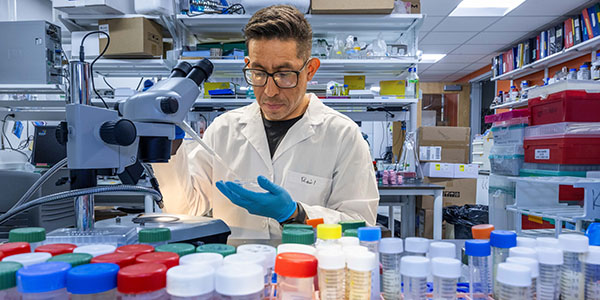University researcher awarded eye foundation grant to study metabolic process in newt eye development and regeneration
Newt research could revolutionize treatment for children’s eye diseases

University researcher awarded eye foundation grant to study metabolic process in newt eye development and regeneration
The Knights Templar Eye Foundation’s mission is “to improve vision through research, education, and supporting access to care.” They support research that can help launch clinical and basic research careers focused on the prevention and cure of blinding diseases in children. Other recipients of this grant in 2025 include the Johns Hopkins University School of Medicine and the Stanford University School of Medicine. Applicants can receive up to $90,000 through the Career-Starter Research Grant.
Newts have the complex and extraordinary ability to regenerate various body parts when damaged, including limbs, tails, vital organs like their heart and brain, and even the lenses and retinas of their eyes. Pérez-Estrada noted that researchers still don’t fully understand newt eye development and how it compares to its regenerative abilities. Metabolism could be a key process that controls eye development and regeneration; therefore, understanding how metabolism is regulated could be key to finding treatments for pediatric eye diseases.
“We know that everybody needs energy to perform tasks like growing, and walking. We need energy, and that energy comes from metabolism. However, in development and regeneration, we don’t know if there is a special requirement for energy to be metabolized for forming eye structures. I want to know all the ways metabolism plays a role during these processes,” Pérez-Estrada said, adding, “I have always thought our habits are very important in inducing or curing diseases. Could our metabolism prevent the development of disease?”
To investigate metabolic factors in eye development and regeneration, Pérez-Estrada's team will collect eye tissue from newts at various developmental and regenerative stages. They'll analyze gene expression patterns through single-cell sequencing to identify metabolic patterns and compare similarities between developing and regenerating eyes. The team will then introduce metabolic inhibitors to observe their effects on eye development and regeneration while also monitoring energy usage during these processes.
Eventually, Pérez-Estrada said he would like to conduct genetic studies to see how mutations affect metabolic processes.
Excited to receive such a competitive grant, Pérez-Estrada explained that it enables him to establish an independent research program — a crucial step toward his goal of becoming a professor. The funding has also created opportunities for students to join his team, gaining valuable hands-on experience with advanced laboratory technology.
“I’m trying to include as many people as I can, especially undergraduates, so they can have that experience with research and also get excited about it,” Pérez-Estrada said.